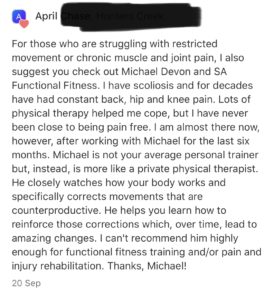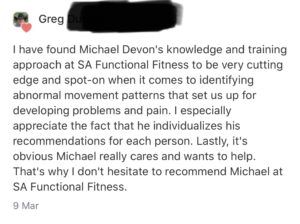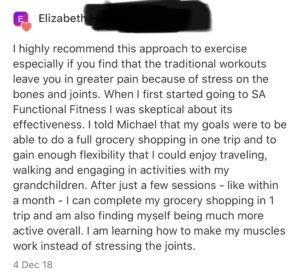If your personal trainer is always injured and they’re teaching you how to work around your injuries without achieving pain free status and return to full function, it’s time to consider that your trainer doesn’t know how to train the intricacies of the human body.
Maybe they’re just a meathead that likes to workout and they’re okay being injured because they think it makes them look cool or tough. But you shouldn’t have to work around their shortcomings. Get yourself a trainer that aims to be better as a trainer for themselves, so they can be a better trainer for you!
Our trainers work through fixing their own muscle dysfunctions, rehabbing old injuries, and finding solutions to nagging aches and pains so they can learn what works for them and break it down in another way to teach their clients that are dealing with the same issues, how to resolve them!
The old saying, “you are who you hang out with” can be said similarly to reflect your fitness. You’re only as “strong,” “functional,” “pain free,” “limitless,” fill in the blank with your own goals, as your trainer. In other words, if your trainer is always hurting somewhere (and it’s not getting better) it means that what they are doing for their own body isn’t worth pursuing because it’s going to lead you down that same path eventually.
In this day in age a skilled personal trainer can also serve your body with the rehabilitation that it needs to get back to working properly. When your body works properly it obtains function that helps it operate without having to avoid certain activities due to pain or injuries restricting its movement.
If your trainer can only give you a workout session- getting your heart rate up, making you sweat, fatiguing your entire body (joints included), by working out around pain and injuries, that’s not going to solve your physical problems. What do you think is going to happen? That magically your body will eventually heal when your trainer hasn’t paid any attention to the areas that need healing, and need very specific detailed work…
Our trainers pay attention to the details to get you off the sidelines and back into the game! Restoring your functions that your body needs to exist and live the life you want, without suffering from pain and being debilitated with an injury. Once the little details are taught and your body’s motor system understand what to do, then we can get your body sweating, your heart rate pumping, and your muscles working and fatiguing in the right places to give you that “good” workout- without avoiding your problems, causing something the flare up, or risking an injury- because your body has been thoroughly prepared!
If you want to workout and simultaneously rehab your body for your future benefit, then ditch the trainer that’s working around the issues that matter to your body in life outside of the gym, and try your introductory session with one of our trainers! Just like when you try on multiple outfits when you shop, or test drive multiple cars before you buy, not all trainers are created equal. Shop around until you find the right one that helps you work through the nitty gritty to fix your physical limitations and achieve pain free function!
















